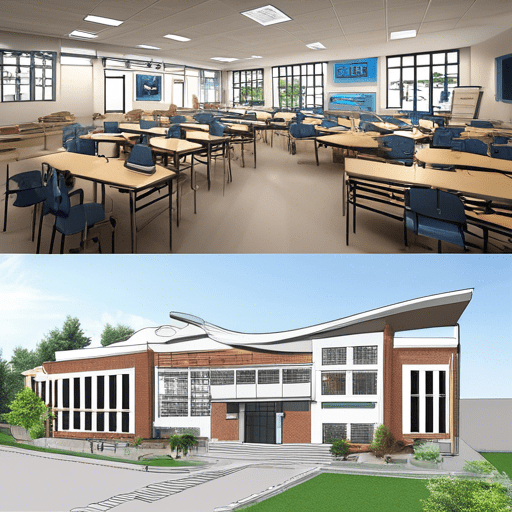Radiant floor heating is becoming an increasingly popular trend in the US, both for retrofit and new projects. Unfortunately, many

Various activities happen at the same time in schools. That’s because school buildings consist of several spaces and rooms that are essential to the education process such as classrooms, music rooms, kitchen cafeterias, offices, labs, library, Gym, etc. As a result, the MEP engineering for school buildings requires a wide range of design skills and competency. More importantly, MEP engineers must have the experience to design rooms for different functions and integrate those systems to avoid competing systems or conflicts.
According to research, MEP systems account for about 60 percent of the total energy used by school buildings every year in the United States. Therefore, it’s important to ensure that MEP design for schools comprises efficient, more sustainable systems. Also, MEP engineers should design smart & effective control systems to facilitate troubleshooting or conflict detection and support effective control of environmental conditions.
Importance of MEP engineering design for schools
Nowadays, learning seems to have grown beyond the classroom as technology continues to provide more diverse learning opportunities. For that, educators require spaces that support the ever-changing teaching methods. Moreover, creating these facilities requires trusted MEP design professionals like Innodez Design & Engineering.
Property conditioned environments in schools can promote a positive learning experience, enhance student performance and reduce absenteeism.
At InnoDez, our goal for MEP design for K-12 projects is to create systems that will meet today’s needs, while addressing the evolving educational paradigms. Also, we focus on teacher and student comfort to ensure that MEP engineering design systems for schools offer occupant set-point adjustment and independent temperature control. This will give staff the flexibility to operate the MEP systems to meet the needs of individual rooms within the educational facility.
In addition, we strive to create MEP systems that are efficient, and easy to maintain to balance the control and comfort of the occupants.
Similarly, our approach to lighting design for school buildings has changed with the advancing lighting and classroom technologies. For instance, our lighting design for schools includes daylight harvesting, dimming, and multi-level switching to offer optimal lighting control to support the different activities happening in classrooms.
Tips for effective MEP engineering design for school buildings
Modern school buildings and educational facilities are being constructed using glass. This helps to improve building aesthetics, provide additional dining space and transform dark, unused spaces into lively social places. In addition, incorporating glass in school buildings offers positive effects like encouraging cooperation, reducing energy costs, and enhancing student performance. At the same time, glass provides a clear vision between spaces, thus creating connectivity and openness.
MEP engineers should consider the use of glass in school buildings for its effects on cooling and heating loads.
According to research analyzing the effect of light on students, bright spaces offer several benefits such as improving teacher morale and promoting faster learning among the students. Luckily, effective MEP design can help to bring in adequate natural light in school buildings, while reducing energy costs.
Architects and MEP engineers should aim to maximize light entering windowless spaces in educational facilities to make temperature control easier. Eco-friendly artificial lighting and daylight can be achieved through glazing, which allows light to pass through effectively. In addition, improvements in glazing and innovations in MEP design for school buildings will improve student performance and lead to higher energy savings.
Modern MEP design systems try to reduce energy costs in every way possible. As already mentioned, using glass in school buildings helps to reduce energy costs. In addition, you can use other techniques such as;
See-through walls
Fire-rated technology is currently being used to create impact- and fire-resistant see-through walls. This allows light through areas deep inside the school building to merge artificial and natural light, while saving energy. At the same time, this improves personal safety and creates a sense of openness.
See-through walls are suitable for use in certain parts of education facilities and school buildings in place of traditional materials like masonry. Some of these areas include; corridors, stairwells, wall partitions, lobbies, interior courtyards, and lightwells.
Energy efficient glazing
Natural light mainly enters a school building through windows. However, you can also use other features such as skylights and glazed doors to bring in extra light. In addition, interior shading devices, light shelves, and interior reflective surfaces can be used to reduce solar heat gain.
To optimize the lighting and visual benefits of glass in a classroom setting, glass manufacturers produce insulated glass, reflective glass, tinted glass, and Low-E coatings. Moreover, these glazing products reduce the amount of heat entering the classroom. Modern educational facilities are also using photovoltaic glazing to capture sunlight and turn it into electricity while allowing students to enjoy adequate natural light and beautiful outdoor views.
Traditional cooling and lighting devices used more than 50% of the total electricity consumed in educational facilities. To solve this issue, the US Green Building Council created the LEED rating system. This system rewards the construction and design of affordable, durable, and eco-friendly practices in spaces and buildings. MEP design for schools can achieve higher LED practices through various strategies like using low-energy electric lighting and daylight to improve the building’s energy efficiency. In addition, schools can get LEED points by;
Contact InnoDez for MEP engineering design for educational facilities!
InnoDez Design & Engineers work closely with maintenance departments, administration, and educational facilities to create MEP (Mechanical, Electrical & Plumbing) design that meets the project’s needs within the school’s timeline and budget. Our MEP designers have worked with many school districts, charter schools, and private schools in California to create flexible, advanced solutions for these complex facilities. Moreover, our approach to MEP design for schools will help your institution see significant cost savings over time while promoting an eco-friendly future.
About Author
InnoDez